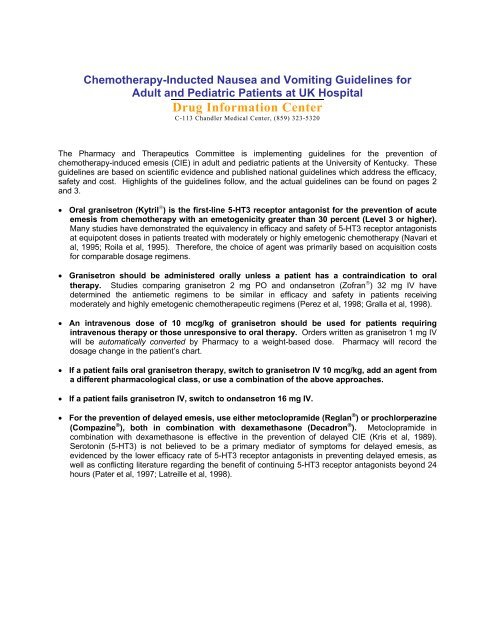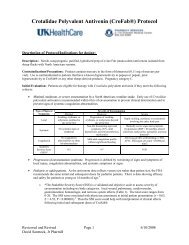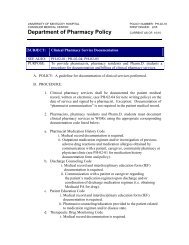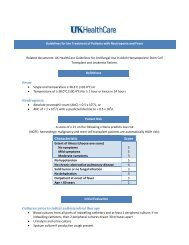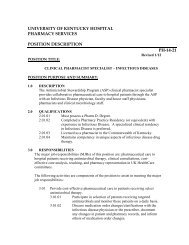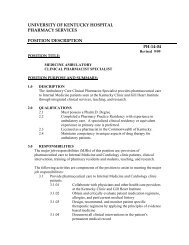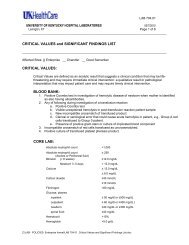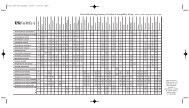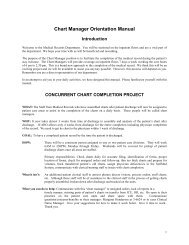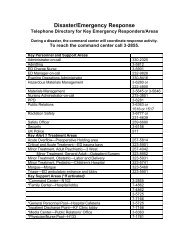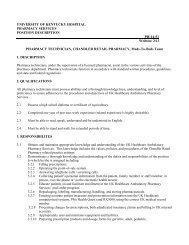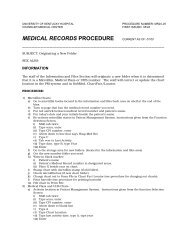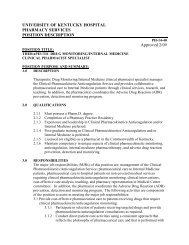Chemotherapy-Inducted Nausea and Vomiting Guidelines for Adult ...
Chemotherapy-Inducted Nausea and Vomiting Guidelines for Adult ...
Chemotherapy-Inducted Nausea and Vomiting Guidelines for Adult ...
You also want an ePaper? Increase the reach of your titles
YUMPU automatically turns print PDFs into web optimized ePapers that Google loves.
<strong>Chemotherapy</strong>-<strong>Inducted</strong> <strong>Nausea</strong> <strong>and</strong> <strong>Vomiting</strong> <strong>Guidelines</strong> <strong>for</strong><br />
<strong>Adult</strong> <strong>and</strong> Pediatric Patients at UK Hospital<br />
Drug In<strong>for</strong>mation Center<br />
C-113 Ch<strong>and</strong>ler Medical Center, (859) 323-5320<br />
The Pharmacy <strong>and</strong> Therapeutics Committee is implementing guidelines <strong>for</strong> the prevention of<br />
chemotherapy-induced emesis (CIE) in adult <strong>and</strong> pediatric patients at the University of Kentucky. These<br />
guidelines are based on scientific evidence <strong>and</strong> published national guidelines which address the efficacy,<br />
safety <strong>and</strong> cost. Highlights of the guidelines follow, <strong>and</strong> the actual guidelines can be found on pages 2<br />
<strong>and</strong> 3.<br />
• Oral granisetron (Kytril ® ) is the first-line 5-HT3 receptor antagonist <strong>for</strong> the prevention of acute<br />
emesis from chemotherapy with an emetogenicity greater than 30 percent (Level 3 or higher).<br />
Many studies have demonstrated the equivalency in efficacy <strong>and</strong> safety of 5-HT3 receptor antagonists<br />
at equipotent doses in patients treated with moderately or highly emetogenic chemotherapy (Navari et<br />
al, 1995; Roila et al, 1995). There<strong>for</strong>e, the choice of agent was primarily based on acquisition costs<br />
<strong>for</strong> comparable dosage regimens.<br />
• Granisetron should be administered orally unless a patient has a contraindication to oral<br />
therapy. Studies comparing granisetron 2 mg PO <strong>and</strong> ondansetron (Zofran ® ) 32 mg IV have<br />
determined the antiemetic regimens to be similar in efficacy <strong>and</strong> safety in patients receiving<br />
moderately <strong>and</strong> highly emetogenic chemotherapeutic regimens (Perez et al, 1998; Gralla et al, 1998).<br />
• An intravenous dose of 10 mcg/kg of granisetron should be used <strong>for</strong> patients requiring<br />
intravenous therapy or those unresponsive to oral therapy. Orders written as granisetron 1 mg IV<br />
will be automatically converted by Pharmacy to a weight-based dose. Pharmacy will record the<br />
dosage change in the patient’s chart.<br />
• If a patient fails oral granisetron therapy, switch to granisetron IV 10 mcg/kg, add an agent from<br />
a different pharmacological class, or use a combination of the above approaches.<br />
• If a patient fails granisetron IV, switch to ondansetron 16 mg IV.<br />
• For the prevention of delayed emesis, use either metoclopramide (Reglan ® ) or prochlorperazine<br />
(Compazine ® ), both in combination with dexamethasone (Decadron ® ). Metoclopramide in<br />
combination with dexamethasone is effective in the prevention of delayed CIE (Kris et al, 1989).<br />
Serotonin (5-HT3) is not believed to be a primary mediator of symptoms <strong>for</strong> delayed emesis, as<br />
evidenced by the lower efficacy rate of 5-HT3 receptor antagonists in preventing delayed emesis, as<br />
well as conflicting literature regarding the benefit of continuing 5-HT3 receptor antagonists beyond 24<br />
hours (Pater et al, 1997; Latreille et al, 1998).
Emetogenicity of Chemotherapeutic Agents<br />
Level 1 (60 mg/m 2 )<br />
Epirubicin hydrochloride (≤90 mg/m 2 )<br />
Mechlorethamine<br />
Idarubicin<br />
Pentostatin<br />
Ifosfamide<br />
Streptozocin<br />
Methenamine (oral)<br />
Methotrexate (250-1000 mg/m 2 )<br />
Mitoxantrone (≤15 mg/m 2 )<br />
*Intrathecal coadministration of methotrexate <strong>and</strong> cytarabine to pediatric patients increases the emetogenicity level to 3.<br />
Calculating Emetogenic Potential of Multiple-Agent Regimens<br />
Identify the agent with the highest emetogenic level, then determine the contribution of the remaining agents by using the<br />
following rules:<br />
Examples:<br />
(1) Level 1 agents do not contribute to emetogenicity. Level 1+1=0 2+1=2 3+1=3 4+1=4<br />
(2) Adding one or more level 2 agents increases the highest level by 1. Level 2+2=3 3+2=4 2+2+2=3 3+2+2=4<br />
(3) Adding level 3 or 4 agents increases the highest level by 1 per agent. Level 3+3=4 3+3+3=5 4+3=5<br />
PEDIATRIC GUIDELINES FOR CHEMOTHERAPY-INDUCED EMESIS<br />
Prevention of Acute Emesis<br />
Level 1<br />
Level 2-5<br />
Granisetron PO (patients able to take PO medications)<br />
OR<br />
Granisetron IV (patients who are not c<strong>and</strong>idates <strong>for</strong> PO)<br />
PLUS<br />
Dexamethasone PO or IV<br />
No preventative therapy necessary<br />
2 mg 30 minutes prior to chemotherapy<br />
10 mcg/kg IV 30 minutes prior to chemotherapy<br />
10 mg/m 2 PO or IV in single or divided doses<br />
Prevention of Acute Emesis – History of Refractory Emesis<br />
Ondansetron IV 0.15 mg/kg 30 minutes prior to chemotherapy <strong>and</strong> q4h x 2<br />
PLUS<br />
Dexamethasone PO or IV<br />
10 mcg/kg IV 30 minutes prior to chemotherapy<br />
Treatment of Breakthrough Emesis<br />
Dexamethasone<br />
OR<br />
Lorazepam (children >5 yrs only)<br />
OR<br />
Promethazine<br />
5-10 mg/m 2 PO or IV q12h prn<br />
0.05 mg/kg (max 2 mg) IV q12h prn<br />
0.25-0.5 mg/kg (max 25 mg) IV q6-8h prn<br />
Treatment of Refractory Emesis<br />
• Increase dose of current agent (within recommended range), OR<br />
• Add agent from different pharmacologic class, OR<br />
• Use a combination of above approaches
ADULT GUIDELINES FOR CHEMOTHERAPY-INDUCED EMESIS<br />
ACUTE EMESIS<br />
PREVENTION<br />
None<br />
5-10 mg PO, IM, or IV q6h PRN, OR<br />
Level 1 Prochlorperazine 25 mg PR q12h PRN, OR<br />
15 mg SR PO q12h PRN<br />
Promethazine<br />
Dexamethasone<br />
12.5-25 mg PO, IM, IV or PR q4-6h PRN<br />
20 mg PO or IV 30 min. be<strong>for</strong>e chemotherapy<br />
5-10 mg PO, IM, or IV q6h, OR<br />
Level 2 Prochlorperazine 25 mg PR q12h, OR<br />
15 mg SR PO q12h<br />
Levels 3-5<br />
Levels 3-5<br />
Promethazine<br />
Dexamethasone<br />
Plus<br />
Granisetron<br />
Dexamethasone<br />
Plus (if IV required)<br />
Granisetron<br />
12.5-25 mg PO, IM, IV or PR q4-6h<br />
20 mg PO 30 min. be<strong>for</strong>e chemotherapy<br />
2 mg PO 30 min. be<strong>for</strong>e chemotherapy<br />
20 mg IV 30 min. be<strong>for</strong>e chemotherapy<br />
10 mcg/kg IV 30 min. be<strong>for</strong>e chemotherapy<br />
DELAYED EMESIS<br />
Cisplatin<br />
Cyclophosphamide<br />
Ifosfamide<br />
Doxorubicin<br />
Carboplatin<br />
Dexamethasone<br />
Plus<br />
Metoclopramide<br />
Or<br />
Prochlorperazine<br />
PREVENTION<br />
Days 2-5<br />
8 mg PO q12h x 2 days, THEN<br />


